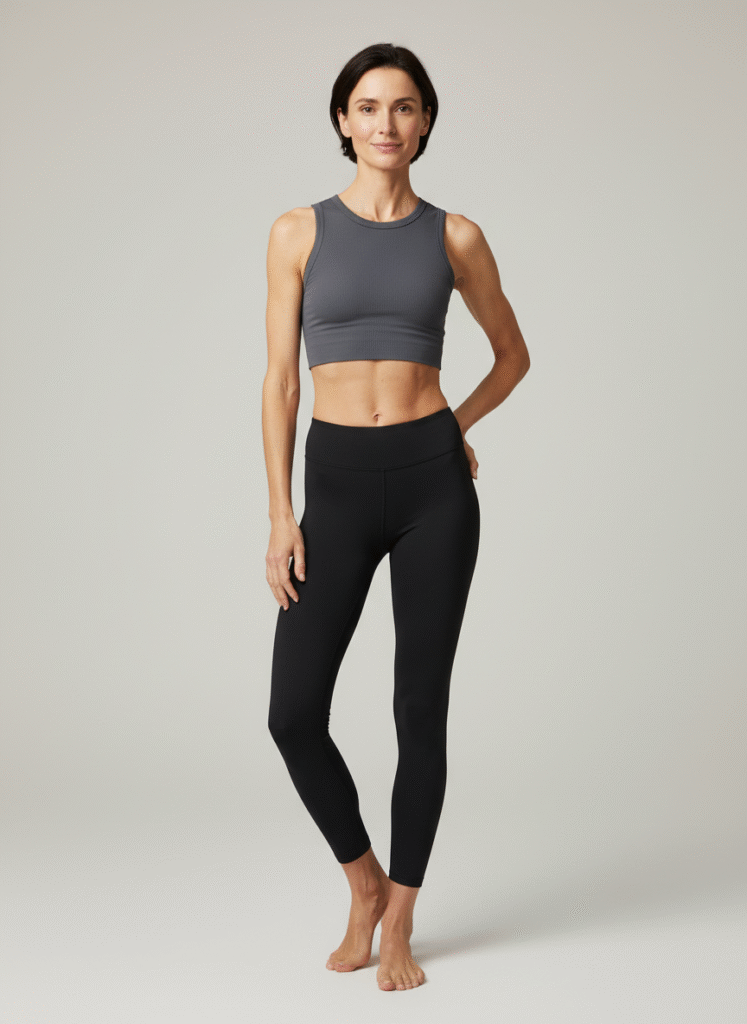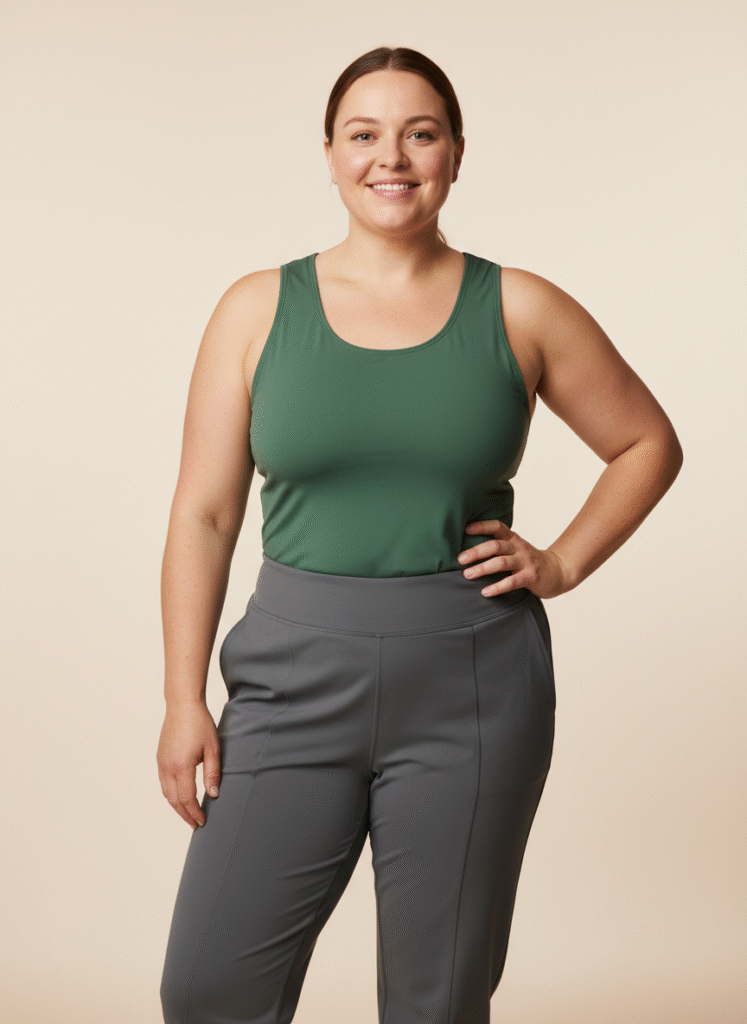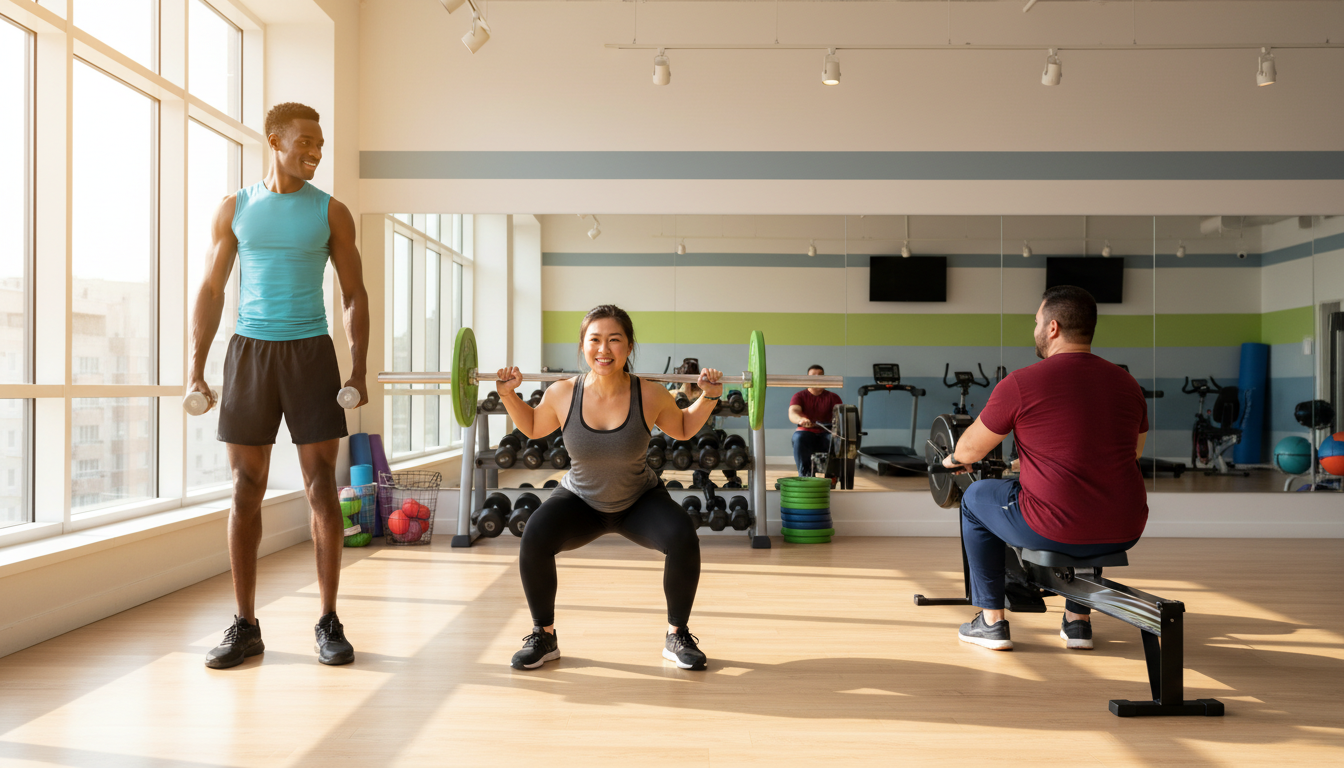Understanding Body Types and Exercise: Your Guide to Working Out Smarter, Not Harder by Vanika
Learn how body types and exercise work together so you can personalize workouts, see real results, and finally stop fighting your own genetics.
Look, I’ll be honest with you — for years, I treated fitness like a universal math equation. Do X workouts, eat Y protein, get Z results. Simple, right? Except it wasn’t. I watched one friend lose fat just by thinking about cardio, while another practically moved into the gym and barely saw a change. That’s when I started paying attention to something most people never really factor in: the relationship between body types and exercise.
Once I understood how body types and exercise actually interact, so many things finally made sense. Why some people gain muscle quickly while others struggle. Why your friend thrives on long runs and you burn out after ten minutes but crush it in strength training. It’s not that your body is broken. It’s that your body is different.
And if your body is different, your workouts should be too.
What Do We Mean by “Body Types”?
Back in the 1940s, psychologist William Sheldon came up with a system called somatotypes — essentially three general body types based on structure and how we tend to carry muscle and fat. Now, to be clear, his attempt to link body types to personality didn’t hold up (thankfully, or we’d all be in trouble), but the physical side of his work still shows up in modern sports science.
The three classic body types are:
- Ectomorph – Naturally lean, often taller or with longer limbs, struggles to gain weight or muscle.
- Mesomorph – Naturally muscular or athletic-looking, gains muscle easily, often responds quickly to training.
- Endomorph – Softer, rounder build, gains weight easily, often has to work harder to lose body fat.
Here’s the thing I wish someone had told me sooner: almost no one is a “pure” type. Most of us live somewhere in the overlap — an ecto-meso, or an endo-meso, or some other fun hybrid that makes clothing sizes a daily adventure.
When you start thinking of body types and exercise as partners in crime instead of enemies, you stop expecting your body to act like someone else’s. That alone can be a game-changer for your motivation.
Ectomorphs: The Lean Machines Who Struggle to Gain
If you’re an ectomorph, you’ve probably heard some version of, “Wow, you’re so lucky, you can eat anything.” Which is great… until you actually want to put on muscle and realize your metabolism is basically a hummingbird on espresso.
Ectomorphs tend to have:
- Narrower shoulders and hips
- Long limbs
- A fast metabolism
- A hard time gaining both fat and muscle
I had a college roommate like this. Let’s call him Jake. Jake would crush an entire pizza at midnight, sleep four hours, and wake up with visible abs. Meanwhile, I’d just walk past the pizza and swear my jeans got tighter. But when he tried to bulk up for wrestling season, it was like trying to fill a bathtub with the drain open.

Strength Training for Ectomorphs
When it comes to body types and exercise, ectomorphs do best with training that focuses on quality over quantity. The goal is to send a loud, clear signal to your muscles to grow — without burning through every calorie you’ve eaten that day.
Think big, compound lifts:
- Squats
- Deadlifts
- Bench presses
- Rows
- Overhead presses
I usually recommend 3–4 sets of 6–10 reps for most exercises. Heavy enough to challenge you, but not so many reps that you’re basically doing cardio with dumbbells.
And here’s the part many ectomorphs resist (trust me, I did too): you need more rest than you think. Training the same muscle group hard more than twice a week is usually overkill. I went through a phase where I hit shoulders three times a week because I wanted “capped delts.” What I got instead was tendonitis and three weeks off pressing anything overhead. Lesson learned the painful way.
Cardio for Ectomorphs
Do ectomorphs need cardio? Yes — your heart still exists. But if your goal is muscle gain, cardio shouldn’t be your main hobby.
Short, purposeful sessions work best:
- 2–3 times per week
- About 20–30 minutes per session
- Either brisk walking, cycling, or short HIIT sessions
I used to run five miles three times a week because I thought that’s what “fit” people did. When I finally admitted I cared more about filling out a t-shirt than improving my 10K time, I cut my runs down, focused on lifting, and — shockingly — my muscles stopped ghosting me.
Eating Like It’s Your Side Hustle
For ectomorphs, nutrition is half the battle. You’re going to need a caloric surplus — usually 300–500 calories above maintenance — and a lot of carbohydrates to fuel training and recovery.
I’ve had phases where eating enough felt like a part-time job. Meal prep containers, protein shakes between meetings, peanut butter on everything. Did it feel glamorous? Not remotely. Did it work with the right exercise strategy for my body type? Absolutely.
Mesomorphs: The “Natural Athletes” (Yes, We’re All Slightly Jealous)
If ectomorphs are trying to gain and endomorphs are trying to lean out, mesomorphs are the people who walk into a gym and their body just… gets the memo.
Mesomorphs often have:
- Naturally broader shoulders
- A relatively narrow waist
- Good muscle definition, even without intense training
- A strong response to strength and cardio work
A study in the Journal of Sports Sciences observed that individuals with more mesomorphic traits tended to respond especially well to resistance training — more strength, more muscle, faster. And if you’ve ever had a mesomorph friend casually “get in shape” in three months, you’ve already seen this in real life.
My cousin Alex is that guy. He took a long break from training, decided to get back into it before his wedding, and within half a year looked like he was about to shoot a fitness commercial. Meanwhile, I was over there counting almonds.

Training Variety for Mesomorphs
Here’s where body types and exercise get interesting: mesomorphs actually need variety more than they need intensity. Their bodies adapt quickly, which is great until you plateau.
Mesomorphs generally thrive on a mix of:
- Strength-focused phases (lower reps, heavier weights)
- Hypertrophy phases (moderate reps and volume)
- Athletic or conditioning phases (circuits, sprints, or sport-specific work)
Research from the European Journal of Applied Physiology has shown that people with mesomorphic builds respond well to both strength and endurance training. In other words, they’re the Swiss Army knives of the fitness world.
Rotating focus every 4–6 weeks — for example, four weeks of strength, then four weeks of hypertrophy — can keep results coming without burning you out.
Cardio and Conditioning for Mesomorphs
Mesomorphs can usually handle 2–4 cardio sessions per week without it sabotaging their gains. That might look like:
- A HIIT workout one day
- A steady-state jog or cycle another
- Maybe a sport, class, or weekend hike
My cousin Alex plays pick-up basketball twice a week, lifts four days, and still recovers like he’s 18. If a mesomorph tried nothing but heavy lifting and ignored cardio altogether, though, they’d be leaving a lot of health and performance benefits on the table.
Endomorphs: Strong, Powerful, and Often Underrated
Let’s talk about the most misunderstood group in the body types conversation: endomorphs.
Endomorphs typically have:
- A softer, rounder appearance
- Wider hips or waist
- A tendency to gain fat easily
- Surprisingly high strength potential
This is the group that often gets the most frustrated with traditional advice. “Just eat less and move more” sounds simple until you’re doing everything “right” and the scale barely moves.
But here’s what I’ve seen over and over again: when endomorphs align body types and exercise properly — especially with the right kind of strength work — the transformation can be dramatic.
One of my friends, Maria, is a textbook endomorph. When she first joined our gym, she spent most of her time on the treadmill, terrified of the weight room. She was doing nearly an hour of cardio every day and eating as little as possible. She was exhausted, frustrated, and ready to quit.
Then a coach convinced her to flip the script.

Strength Training First, Cardio Second
For endomorphs, strength training isn’t optional — it’s the foundation.
A review in Obesity Reviews found that resistance training can significantly improve body composition in people with higher body fat, sometimes outperforming cardio alone in terms of fat loss and muscle gain. Muscle mass increases your resting metabolic rate, which means you burn more calories even when you’re doing absolutely nothing. (Yes, that includes binge-watching your favorite show.)
For most endomorphs, a good setup looks like:
- 3–4 days per week of resistance training
- 4–5 sets of 10–15 reps on big compound movements
- Shorter rest periods (30–60 seconds) to keep your heart rate up
Circuit training, supersets, and metabolic-style workouts work especially well here — they blend strength and cardio in a way that respects how this body type responds to exercise.
I’ve watched Maria go from being afraid of the barbell to deadlifting over 300 pounds. She didn’t get there by living on a treadmill. She got there by owning her strength and using it.
Smart Cardio for Endomorphs
Unlike ectomorphs, endomorphs usually benefit from more consistent cardio — but not just endless, slow miles.
A balanced approach could include:
- HIIT 2–3 times per week (20–30 minutes)
- Moderate steady-state cardio 2–3 times per week (30–45 minutes)
Too much cardio, though, can backfire. If you’re drained all the time, your strength sessions will suffer, and strength is your secret weapon.
The sweet spot is enough cardio to help create a calorie deficit and support heart health, without doing so much that your body feels like it’s under permanent attack.
Most of Us Are Hybrids (And That’s a Good Thing)
Here’s the fun twist: most people are some mix of these body types.
You might be:
- An ecto-mesomorph: generally lean, but able to build muscle with focused work
- An endo-mesomorph: gains both fat and muscle easily, often very strong
- Somewhere else in between, with traits from more than one group
Personally, I sit somewhere around ecto-meso. I stay relatively lean without trying too hard, but I don’t pack on muscle nearly as fast as my more mesomorphic friends. Once I accepted that, everything about my training got calmer. I stopped expecting three-month miracles and started aiming for steady progress over years.
I also train with a guy who’s this fascinating ecto-endo blend — skinny arms and legs but carries most of his fat around his midsection. For him, dialing in body types and exercise meant focusing on heavy strength work to build up his limbs while using more cardio and conditioning to target overall fat loss. His program doesn’t look like mine, and it shouldn’t.
Common Mistakes People Make with Body Types and Exercise
One of the biggest mistakes I see? Treating body type as a life sentence instead of a starting point.
“I’m an endomorph, I’ll never have abs.”
“I’m an ectomorph, I’ll never be strong.”
“I’m a mesomorph, I don’t need to worry about what I eat.”
None of those are actually true.
A study in Medicine & Science in Sports & Exercise showed that people with all kinds of body compositions could dramatically improve muscle mass, strength, and fat levels with the right combination of training and nutrition. The playing field isn’t perfectly level — some people will always have an easier road — but everyone can move the needle.
Another mistake? Assuming everyone with the same label needs the exact same workout.
I’ve trained with two people who both looked like classic endomorphs. One thrived on high training volume: lots of sets, lots of days in the gym. The other did better with fewer, more intense sessions and more recovery time. Same basic body type, totally different sweet spots.
Body types give you clues. They’re not a full instruction manual.
Your Body Doesn’t Read the Textbook
There’s one more factor that often gets left out of the body types and exercise conversation: real life.
Your results are shaped by things like:
- Sleep (or lack thereof)
- Stress
- Age
- Hormones
- Job and daily movement
- Training history
You can take two mesomorphs, give them the same program, and still get different outcomes because one sleeps eight hours a night and the other is up till 2 a.m. doomscrolling.
A paper in the Journal of Applied Physiology even found that individual responses to the same training program varied dramatically. Some people were “high responders,” others were “low responders,” and that variation was bigger within groups than between them. Translation: who you are as an individual matters just as much as your body type.
This is why I love using body types not as fixed labels, but as a starting hypothesis. You look at your build, your tendencies, your history, and you say, “Okay, I probably lean ectomorph,” or “I’ve got a lot of endomorph traits.”
Then you test. You adjust. You pay attention.
How Your Approach Can Evolve Over Time
Here’s something I didn’t expect in my own journey: your body can shift along this spectrum over the years.
In my early twenties, I was a full-on ectomorph — the kind of person who could eat an entire box of cereal and still look like I’d borrowed someone else’s t-shirt. After years of lifting, eating more, and generally treating my body better, I’ve crept closer to the mesomorph side. I gain muscle more easily now… but I also gain fat more easily than I used to.
That means the way I think about body types and exercise has changed. I used to worry only about gaining. Now I pay more attention to balance — keeping the muscle I’ve worked for while not pretending I can just bulldoze through entire pizzas forever.
You might notice the same thing. Maybe you’re an endomorph who’s built a lot of muscle over the years and now finds it easier to maintain leanness than before. Maybe you’re a lifelong mesomorph who hits your forties and realizes recovery doesn’t happen overnight anymore.
The plan that worked at 22 doesn’t always work at 35 or 45. And that’s not failure — it’s just biology asking for an update.
Pulling It All Together: A Smarter Way to Train
If you’ve read this far (first of all, high five), here’s the bottom line: understanding body types and exercise isn’t about boxing yourself in. It’s about giving yourself better starting conditions.
Ectomorphs usually do best with:
- Heavy, compound lifting
- Limited cardio
- Generous calories and carbs
- Plenty of recovery
Mesomorphs usually shine with:
- A mix of strength, hypertrophy, and conditioning
- Regular, moderate cardio
- Periodized training blocks
- Enough food to fuel performance without drifting into autopilot eating
Endomorphs usually thrive with:
- Strength as the base
- Smart, consistent cardio
- Higher overall activity
- A nutrition plan that creates a gentle calorie deficit without going extreme
But at the end of the day, the most important plan is the one you’ll actually stick with. If the “perfect” program for your body type makes you miserable, it’s not perfect for you.
Making Peace with Your Body Type
I’ve come to like the hand I was dealt. Being more on the ectomorph side means I’ve had to work harder for muscle, but it’s also made me more patient. It forced me to pay attention, to learn how my body responds, to actually understand this whole body types and exercise thing on more than just an academic level.
My friend Maria, the strong endomorph, once said something that stuck with me: “I used to hate my body for not being lean like everyone else. Now I love it for being able to lift what most people can’t budge.” That’s what happens when you stop fighting your body and start working with it.
So here’s my honest encouragement: figure out where you roughly land on the body type spectrum. Use that to guide your first draft of a training plan. Then tweak based on your real-world results.
Your body type is your starting point, not your final score.

Final Thoughts: Your Body, Your Blueprint
When you zoom out, the relationship between body types and exercise is really about personalization. It’s about trading one-size-fits-all workouts for something more honest. More realistic. More you.
You’re not broken if you don’t respond to the same program your friend swears by. You’re not doomed because you gain fat easily or struggle to add size. You just need a strategy that respects how your body is built.
Use body types as a guide. Let research shape your decisions. Pay attention to how you feel and how you recover. And give it enough time to actually work — because the most underrated training principle, regardless of body type, is consistency.
When you finally stop trying to turn your body into someone else’s and start training the one you actually have, fitness gets a lot less frustrating — and a lot more effective. And if you can laugh at yourself a little along the way? Even better.







